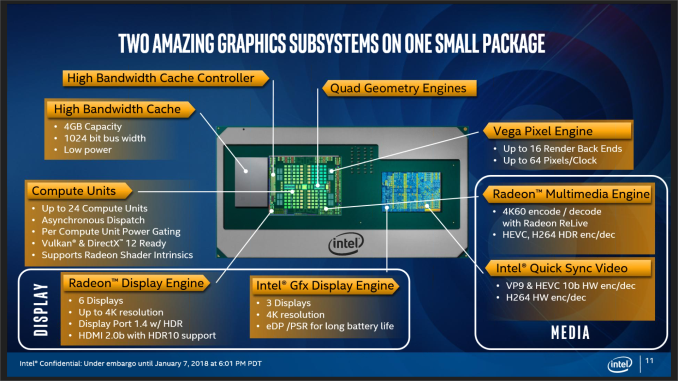Intel Core with Radeon RX Vega M Graphics Launched: HP, Dell, and Intel NUC
by Ian Cutress on January 7, 2018 9:02 PM ESTSo Why Two Sets of Graphics?
To answer this question, there can be a few possible answers.
The cynical approach is to say that Intel is rehashing a H-series design for the CPU portion, so rather than spending money to make masks that cuts it off, Intel is being cheap for what would be a low volume product.
A technical reason, which readers may or may not agree with, is to do with functionality and power. Despite these chips being 65W and 100W, we are going to see them being used in 15-inch and 17-inch high-end devices, where design is a lifestyle choice but also battery life is a factor to consider. For doing relatively simple tasks, such as video decoding or using eDP, firing up a big bulky graphics core with HBM2 is going to drain the batteries a lot faster. By remaining on the Intel HD graphics, users can still have access to those low power situations while the Radeon graphics and HBM2 are switched off. There is also the case for Intel’s QuickSync, which can be used in preference of AMD encoders in a power-restricted scenario.
The Radeon graphics in this case offers power-gating at the compute-unit level, allowing the system to adjust power as needed or is available. It provides an additional six displays up to 4K with the Intel HD graphics that has three, giving a total of nine outputs. The Radeon Graphics supports DisplayPort 1.4 with HDR and HDMI 2.0b with HDR10 support, along with FreeSync/FreeSync2. As a result, when the graphics output changes from Intel HD Graphics to Radeon graphics, users will have access to FreeSync, as well as enough displays to shake a stick at (if the device has all the outputs).
Users that want these new Intel with Radeon Graphics chips in desktop-class systems, might not find much use for the Intel HD graphics. But, for anything mobile or power related, and, especially for anything multimedia related, it makes sense to take advantage of the Intel iGPU.











66 Comments
View All Comments
B166ER - Sunday, January 7, 2018 - link
Exaggeration to emphasize a point..tipoo - Monday, January 8, 2018 - link
What's the point if it doesn't remotely make sense? That's not an exaggeration, it's just not the truth, the dGPU is significantly better than any Intel iGPU.Cooe - Monday, January 8, 2018 - link
Umm. Lol can you read? Perhaps you need your eyes checked? Because I really can't fathom how you ended up at THAT conclusion. This is a near GTX 1060 level part we're talking about here (and well beyond the 1050Ti). As others have said, it'll fall right around the MaxQ version of the 1060. That's damn impressive considering the size & power envelope.OEMG - Sunday, January 7, 2018 - link
In page 4 ("Intel’s Performance Numbers") the last table's headers are wrong (should be GH vs 1060).I wonder how FreeSync would work if they're powering down the pGPU. One guess is some sort of mode switching to the iGPU's display engine as for light workloads the iGPU is more than capable to maintain max display frame rate. But then, there's some protocol stuff being done in FreeSync/G-Sync so it could also be that the pGPU's display engine would always be on with the iGPU feeding into it.
neblogai - Sunday, January 7, 2018 - link
On 4th page, last two charts (and also text between them) should have GH series part, instead of i7-8509G Vega M GL.StevoLincolnite - Sunday, January 7, 2018 - link
"Coffee Lake processors, using Intel’s latest 14++ process and running up to 8 cores."I could have sworn they only topped out at 6-cores.
nerd1 - Sunday, January 7, 2018 - link
I don't get it, AMD GPU has never been good for efficiency, but now they claim to beat NVdia 1050/1050 ti in terms of efficiency.... sounds too good to be true.tipoo - Sunday, January 7, 2018 - link
EMIB + HBM2 + a multichip module with Intel is what it takes apparently. With all those edges, I'm sure it can manage to edge out 1050 perf/watt like they say, it's not all in the architecture.tipoo - Sunday, January 7, 2018 - link
Also states power sharing saves 18 watts, so that's a lot of handicaps for the more efficient Pascal to catch up with.Cooe - Monday, January 8, 2018 - link
EMIB adds nothing performance or efficiency-wise over a regular interposer like AMD uses. It's simply thinner/cheaper. Also, people drastically undervalue how power efficient Vega is when clocked in it's efficiency "sweet spot". The reason it looks so bad in Vega 56/64 (the latter especially) is because the clocks have been pushed right up to the process' limits, and well, well beyond said "sweet spot". The clock's being used here, otoh, fall right within it (for obvious reasons). I think people are going to be very surprised by both the efficiency here, and in the Vega Mobile dGPU AMD announced today (which could very well be based off this graphics part, but we'll know soon enough. I'd bet my lunch it ends up in discrete desktop cards as well at some point to replace at-least the 560 & 570, and possibly 580).